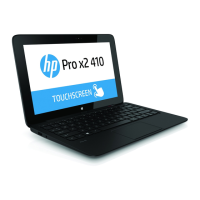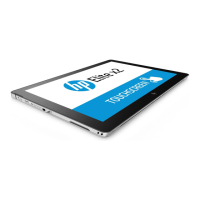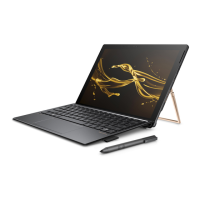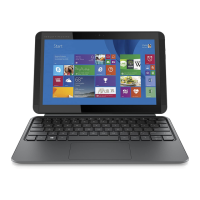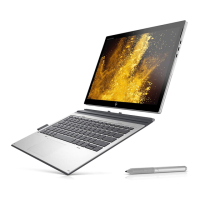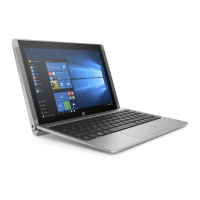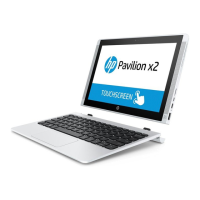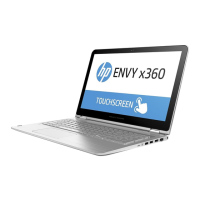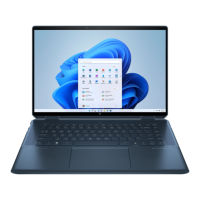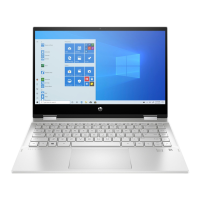Do you have a question about the HP Pro x2 612 G1 and is the answer not in the manual?
Locating resources, product details, and how-to information.
Identifies and describes components on the edges of the tablet.
Details the components and features of the power keyboard.
Explains how to use the TouchPad and its various gestures.
Guides users on establishing wireless network connections like WLAN and Bluetooth.
Instructions for connecting the computer to a network using a cable.
Covers using the TouchPad, mouse, and digitizer pen for navigation.
Explains keyboard functions, hot keys, and numeric keypads.
How to manage audio settings, connect speakers, headphones, and microphones.
Information on using webcams and connecting external displays via VGA/DisplayPort.
Procedures for safely shutting down the computer and emergency procedures.
Information on battery life, charging, managing low battery levels, and conserving power.
Instructions for inserting and removing memory cards.
How to connect and disconnect USB devices.
Precautions and guidelines for handling internal and external drives.
Overview of security features like BIOS, passwords, and encryption.
Guidance on keeping the operating system and software updated for security.
Steps and recommended products for cleaning the computer safely.
Instructions for downloading and installing the latest HP software and drivers.
Process for creating recovery media and backing up system data.
Steps to restore the computer to a previous state or factory settings.
How to access and navigate the BIOS/Computer Setup utility for system configuration.
Procedures for determining the BIOS version and downloading updates.
Configuring boot order and preferences for multiple operating systems.
Running diagnostic tests to determine computer hardware functionality.
How to get help from HP support via chat, email, or phone.
Details on the computer's power requirements and voltage specifications.
Links and information for accessing HP support and troubleshooting tools.
Solutions for common problems like startup failures, blank screens, and software errors.
Locating resources, product details, and how-to information.
Identifies and describes components on the edges of the tablet.
Details the components and features of the power keyboard.
Explains how to use the TouchPad and its various gestures.
Guides users on establishing wireless network connections like WLAN and Bluetooth.
Instructions for connecting the computer to a network using a cable.
Covers using the TouchPad, mouse, and digitizer pen for navigation.
Explains keyboard functions, hot keys, and numeric keypads.
How to manage audio settings, connect speakers, headphones, and microphones.
Information on using webcams and connecting external displays via VGA/DisplayPort.
Procedures for safely shutting down the computer and emergency procedures.
Information on battery life, charging, managing low battery levels, and conserving power.
Instructions for inserting and removing memory cards.
How to connect and disconnect USB devices.
Precautions and guidelines for handling internal and external drives.
Overview of security features like BIOS, passwords, and encryption.
Guidance on keeping the operating system and software updated for security.
Steps and recommended products for cleaning the computer safely.
Instructions for downloading and installing the latest HP software and drivers.
Process for creating recovery media and backing up system data.
Steps to restore the computer to a previous state or factory settings.
How to access and navigate the BIOS/Computer Setup utility for system configuration.
Procedures for determining the BIOS version and downloading updates.
Configuring boot order and preferences for multiple operating systems.
Running diagnostic tests to determine computer hardware functionality.
How to get help from HP support via chat, email, or phone.
Details on the computer's power requirements and voltage specifications.
Links and information for accessing HP support and troubleshooting tools.
Solutions for common problems like startup failures, blank screens, and software errors.
| Form factor | Convertible (Detachable) |
|---|---|
| Product type | Hybrid (2-in-1) |
| Product color | Black |
| Country of origin | China |
| Market positioning | Business |
| Bus type | DMI2 |
| Stepping | D0 |
| Tjunction | 100 °C |
| Processor cache | 3 MB |
| Processor cores | 2 |
| System bus rate | 5 GT/s |
| Processor family | Intel® Core™ i3 |
| Processor series | Intel® Core™ i3-4000 Mobile Series |
| Processor socket | BGA 1168 |
| Processor threads | 4 |
| Processor codename | Haswell |
| Processor frequency | 1.5 GHz |
| Processor cache type | Smart Cache |
| Processor lithography | 22 nm |
| Processor manufacturer | Intel |
| Processor front side bus | - MHz |
| PCI Express slots version | 2.0 |
| Processor operating modes | 64-bit |
| ECC supported by processor | No |
| PCI Express configurations | 4x1, 2x4 |
| Thermal Design Power (TDP) | 11.5 W |
| Scenario Design Power (SDP) | 6 W |
| Maximum number of PCI Express lanes | 12 |
| Motherboard chipset | - |
| Internal memory | 4 GB |
| Memory clock speed | 1600 MHz |
| Memory form factor | On-board |
| Internal memory type | DDR3-SDRAM |
| Maximum internal memory | - GB |
| SSD capacity | The Solid State Drive's storage capacity in Gigabytes. |
| SSD interface | SATA |
| Storage media | SSD |
| Total storage capacity | 128 GB |
| Number of SSDs installed | 1 |
| Display diagonal | 12.5 \ |
| Touch technology | Multi-touch |
| Native aspect ratio | 16:9 |
| On-board graphics card ID | 0x402 |
| On-board graphics card model | Intel® HD Graphics 4200 |
| On-board graphics card family | Intel® HD Graphics |
| Maximum on-board graphics card memory | 2 GB |
| On-board graphics card base frequency | 200 MHz |
| On-board graphics card DirectX version | 11.1 |
| On-board graphics card dynamic frequency (max) | 850 MHz |
| Display technology | IPS |
| Intel segment tagging | Enterprise, Small Business |
| Intel® Virtualization Technology (Intel® VT) | VT-d, VT-x |
| Wi-Fi standards | 802.11a, Wi-Fi 5 (802.11ac), 802.11b, 802.11g, Wi-Fi 4 (802.11n) |
| Top Wi-Fi standard | Wi-Fi 5 (802.11ac) |
| USB 2.0 ports quantity | USB 2.0 ports have a data transmission speed of 480 Mbps, and are backwards compatible with USB 1.1 ports. You can connect all kinds of peripheral devices to them. |
| Operating system installed | Windows 8.1 |
| Processor code | SR1C7 |
| Processor ARK ID | 76608 |
| Intel TSX-NI version | 0.00 |
| Processor package size | 40 x 24 x 1.5 mm |
| Intel ME Firmware Version | 9.5 |
| Supported instruction sets | AVX 2.0, SSE4.1, SSE4.2 |
| Intel Smart Connect Technology version | 1.00 |
| Battery capacity | 29 Wh |
| Battery life (max) | - h |
| Width | - mm |
|---|---|
| Weight | - g |
